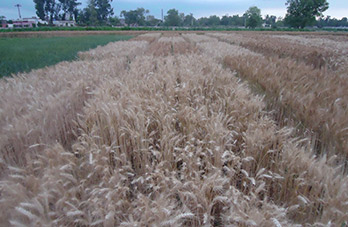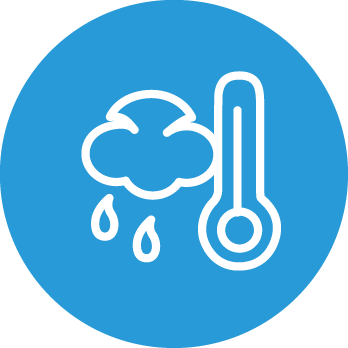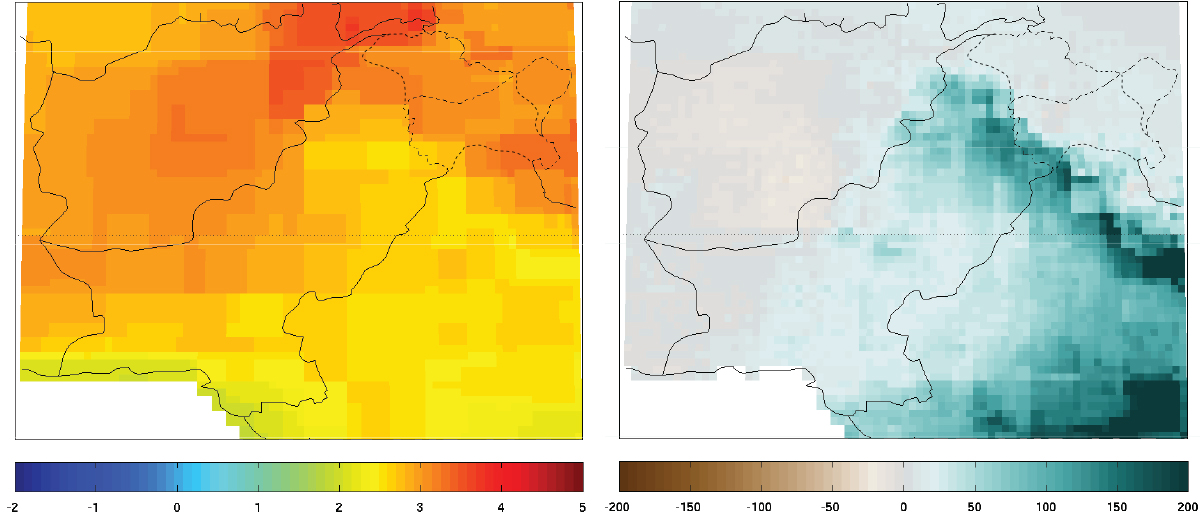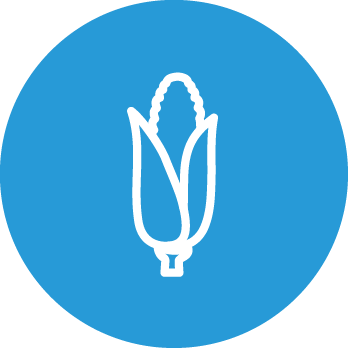South Punjab, Pakistan
Adapting cotton-wheat farming systems

Current Farming System
Small, Medium and Large Farms
Irrigated
Cotton-Wheat Cropping System
Good soil fertility

CLIMATE 2050s
Increase in temperature of at least 2.5 °C up to 3.6 °C
Uncertain projected changes in rainfall – median increases but potential for up to 52% decline in cotton growing season and 42% in wheat growing season
IMPACTS
Mean cotton yield losses of 47% under higher temperatures
Wheat yields stable or decline by 2% to 4.5%

VULNERABILITY 2050s
Poverty of farmers could increase by up to 17% under climate change with high emissions
Per capita income is reduced by 14% to 35%

ADAPTATIONS
Adaptations of drought-resistant and heat-tolerant seed varieties, management improvements, water conservation, efficient irrigation, agricultural insurance, and farm mechanization reduces poverty by 24% to 65%
 Results Overview
Results Overview
Economic growth and development in Pakistan is profoundly linked with agriculture. Agriculture contributes 19.8% of the gross domestic product, employs 42.3% of labor force, and helps sustain the productivity of other sectors of economy. Agricultural productivity, and therefore a significant portion of the population, is affected by climatic changes. These changes can impact agriculture both biophysically, i.e. affecting yields, and economically, i.e. affecting prices. This study quantifies the climate impacts on agricultural production systems in Punjab Pakistan both today and in the future.

The Punjab region of research focus within Pakistan
A large proportion of Punjab, Pakistan farmers are cotton-wheat farmers. The cotton-wheat cropping system is considered a "grain plus cash" cropping system. Cotton is sold as an industrial product and increases farmers' income while wheat improves food security. These crops contribute greatly to improvements in the economic conditions of a large number of people engaged in farming, processing trade, and the textile industry.
To maximize economic returns on cotton, many farmers delay the last picking of cotton from the beginning of December to the first week of January. Moving the last harvest back subsequently delays the first planting of wheat crops. Delayed wheat planting causes reductions in wheat yields, as delayed planting can leave wheat exposed to hot weather during critical flowering and grain formation periods. On average, delaying wheat planting after mid-November can cause up to 1% yield losses per day per hectare. Furthermore, the delayed wheat planting and subsequent harvest causes cotton planting to be delayed as well. While the late planting (and harvest) can improve economic returns, delayed cotton planting is very risky. Severe insect and pest attacks, as well as the incidence of cotton leaf curl virus, are increasingly threating with delayed cotton planting.
Several actions can be taken to improve cotton yields in a late sowing/harvest system. This includes using genotypes resistant to cotton leaf curl virus, and fit to high population density. The use of high-density cotton promotes more cotton to be grown per hectare. Close row spacing and high plant populations in ultra-narrow rows lead to more rapid canopy closure than in wider row spacing (Robinson, 1993). This encourages increased light interception and reduced weed competition (Kreig, 1996). Developing short duration and early maturing cotton cultivars, and ensuring timelier sowing of wheat, could also improve yields. In all situations, appropriate technology for intercropping in widely spaced cotton must also be developed in an urgent manner.
Climatic changes could further threaten agricultural productivity. Projected local warming (between 1°C to 3.6°C), shifts in seasonal distribution of rainfall, an increase in rainfall variability, and an increase in the frequency of extreme events, could all have adverse impacts on production. Already, warm spells and warm days have become more frequent, and maximum and minimum temperatures have also changed.
Projected changes in rainfall are less clear for the mid-century (2040-2069). Some models indicate wetter or stable conditions in the future while the hotter and drier climate models indicate possible precipitation decreases of up to 52% during the cotton-growing season and up to 42% during the wheat-growing season.
If today's technology and farm practices are used in the future, climate change, especially increased temperature, could cause cotton yields to decrease by up to 47% and wheat yields to decrease by up to 4.5%. These changes in yields are largely attributed to temperature – most of the land is irrigated. This could cause net farm returns and per capita income to decrease. Additionally, the percentage of farmers in poverty (living on under $1.25 per person per day) would increase from 1.2% to 17%.
Farmers can reduce the threat of vulnerability by adapting improved practices. These management practices can improve yields today. These practices include, for cotton, increasing nitrogen fertilizer by 10%, spreading row spacing by 15%, and providing a cash subsidy for smallholder farmers. In addition, improving practices for wheat by incorporating better methods of fertilizer application, increase in sowing density, and sowing seeds at earlier dates would also have positive impacts on farm returns and per capita income.
 Farming System
Farming System

Wheat field in Punjab, Pakistan
The cotton-wheat cropping system is well established in South Asia and is particularly prominent in Pakistan and Northern India. For the last 50 years this cropping system has occupied a significant place in the agricultural growth of the country. The cotton-wheat cropping system is considered a "grain plus cash" cropping system. Cotton is cultivated as an industrial product while wheat is cultivated as a constituent to food security. The cropping system is extremely remunerative and provides reliable income for the farmers. 7.9 million hectares of agricultural area is under the cotton-wheat farming system in Pakistan (FAO, 2012).
Cotton and wheat crops contribute greatly to enhanced economic conditions for a sizeable portion of the population engaged in farming, processing trade, and the textile industry. The introduction of dwarf wheat, which requires lower temperatures for good germination than the traditional tall local wheat cultivars, has improved wheat yields. Improvements were also brought about by the initiation of short duration, early-maturing varieties and expansion of assured irrigation facilities in the cotton growing belts of the southern parts of the country, especially in Punjab and the neighboring Sindh province.
Today the cotton-wheat system is the second most important and profitable in the country and ensures the food security as well as financial security of most of the population. With the availability of new varieties, matching production technology, and increased use of farm power and machinery for timely field operations, the productivity of the cotton-wheat production system has improved significantly over the years (Mayee et al., 2008). Cotton is also the most important foreign exchange earner through export of raw cotton, readymade garments, clothes, and cottonseed byproducts in the form of edible oil and oil cake.
Cotton utilizes canal irrigation and is planted between mid-April and mid-May, growing to October-November. The cotton planting season is quite hot, with temperatures above 35 °C, bright sunshine, and high wind velocity. Cotton is very dependent on climatic requirements for its proper growth and development. Wheat is grown during the winter season with November planting on stored soil moisture with supportive irrigation. Wheat sown in November matures by the end of April or first fortnight of May and the fields are then mechanically prepared quickly for cotton sowings. The rainy season in this agricultural belt is from July-October, when nearly 400-600 mm rainfall is received. Some rain (5 to 10% of the total annual) is received during winter (November-March) but this is not evenly distributed across the region.
 Climate Change Projections
Climate Change Projections

Median changes in June-April (left) temperature (°C) and (right) total precipitation (mm) from 29 climate model simulations for Pakistan and surrounding countries in the 2050s under a high emissions climate change scenario, compared with the 1980-2010 historical period.
Historical observations find that the average maximum regional temperature is 33.1°C annually, 40.2°C during the cotton season, and 27.2°C during the wheat season. Corresponding minimum temperatures are 18.2°C on an annual basis, 27.2°C for the cotton season, and 10.9°C for the wheat season. Annual total rainfall averaged over the 5 Punjabi districts is 2000 mm, averaging 1175 mm during the cotton season and 488mm during the wheat season.
The observed recent climate trends in Punjab demonstrate temperature changes are consistent with global trends of increased minimum and maximum temperatures. However there are highly heterogeneous change patterns observed in precipitation owing to its high inter-annual variability associated with the South Asian monsoon that dominates the region.
For this study, the region's integrated assessments considered two emissions pathways and 5 climate characteristic groupings. The study used RCP4.5 (moderate carbon emissions) and RCP8.5 (high carbon emissions) to consider pathways in association with a "Cool/wet," "Hot/wet," "Middle," "Cool/dry," and "hot/dry" climate condition. In total, 10 different scenarios were examined in the assessment.
When considering the high carbon emissions and hot temperatures, the models suggest that the cotton season will be warmest in the hot/wet scenario, while the wheat season will be warmest in the hot/dry scenario. In the hot/wet scenario, the cotton season's maximum and minimum temperatures are expected to increase by 3.6°C and 4.3°C, respectively. In the hot/dry scenario, the wheat season's maximum and minimum temperatures are projected to increase by 3.7°C and 3.8°C, respectively.
Precipitation projections depict high uncertainty in all months over the region, due in large part to model difficulties in representing interactions between climate change and the South Asian monsoon. Projections ranged from both substantially drier conditions (up to 28% annual decline) to substantially wetter conditions (up to 23% increase). To consider all uncertainty for risk management, this spectrum of projections was considered in the analysis.
 Climate Change Impacts
Climate Change Impacts

Results of crop model projections for the 2050s under high (orange) and moderate (green) emissions scenarios.
Cotton yields are highly sensitive to climate change, while wheat yields are apparently less impacted. The analysis shows impacts are relatively consistent in both moderate and high emission futures.
Change in wheat and cotton yields in a moderate emission future: Crop models project that climate change would cause mean cotton yields to reduce by 42% and wheat yields by 4.5% under moderate greenhouse gas emissions for mid-century (2040-2069). However, there is considerable uncertainty due to the various climate model projections and crop model sensitivities. Projections are more certain under the smaller climate changes associated with the moderate emissions scenario, and there is strong agreement that the hottest climate scenarios under each emissions pathway will lead to considerable yield declines (especially for cotton, which declines by up to 67%).
Change in wheat and cotton yields in a high emission future: Projections suggest cotton yields may reduce as much as 47% and wheat yield by 2% for mid-century (2040-2069). Again, there is wide uncertainty from climate and crop models. Analysis shows these yields decreased more in the higher emissions scenario because maximum and minimum temperatures were clearly larger, with declines of up to 82% for cotton. It is possible for wheat yields to increase up to 9% under wetter conditions and little warming, but only under this scenario.
 Vulnerability
Vulnerability
Current System Vulnerability
The results of both crop models suggest that 59% to 87% of households at aggregate level may be vulnerable under moderate emissions, while 61% to 92% may be vulnerable under the high emissions scenario. Negative net impacts of changing climatic conditions on the cropping system include increase in poverty ranging from 7% to 112% under the moderate emissions scenario and 14% to 195% under the high emissions scenario. Climate change increases the percentage of the population in poverty under all scenarios as net returns are negative and per capita income also decreases largely due to adverse impacts on cotton.
Climate Change Impacts on Future Agricultural Production System
Future agricultural production systems are designed with the help of Representative Agricultural Pathways (RAPs) that show how future socio-economic conditions will change the nature of Punjabi agriculture in the future, including farm management, agricultural policy, and market structures. RAPs were designed under the light of global socio-economic trend models, then refined for national and regional levels through a sustained engagement process with stakeholders and policymakers. Characteristics of these future farming systems are incorporated into crop and economic model simulations to understand how future systems are resilient to climate impacts, allowing distinction between major storylines of future development.
Narrative for the "Green Road" Representative Agricultural Pathway
On the Green Road, Government efforts may focus on food security and sustainable development. Governments and increased public investment could help support the agriculture sector. This investment may help achieve self-sufficiency and improved viability. Investments could be made into research, technology, infrastructure, and extension services to elevate sustainable farm productivity. Educational and health investments may help accelerate the demographic transition, leading to a relatively lower population growth. The government could also liberalize food grain imports and may invest in food supply chains as well as improved research and development.
Narrative for the "Grey Road" Representative Agricultural Pathway
On the Grey Road, the agricultural sector may face escalating international demands for food and fiber. As a result, the sector will turn to the help of technological advancement. Production will increase over time due to various factors such as on-farm technological advancements and improved cultivars. Consistent mechanized farming, increasing crop intensity and disturbances in the natural ecosystem, will degrade natural resources in agricultural production systems. A growing pressure to diversify production systems in order to grab market and trade advantage will alter the production systems of the Punjab region.
 Adaptations
Adaptations
Agricultural production systems are complex, interlinked, and highly dependent on characteristics of the natural ecosystem. Crop production is a notably climate-sensitive sector of the economy. Anticipation and adaptations of all these impacts of climate change is very important tool for the developing economies.
Planned and unplanned adaptations help reduce climate vulnerability in agricultural systems and attempt to maintain ecosystem balance while minimizing economic losses. Policies promoting rapid socioeconomic development must have a synergistic effect with climate change to improve national adaptive capacity. Adaptation strategies at both the farm level and national level can help minimize climate losses.
To examine the benefits of adaptation efforts, adaptation packages were to combat current and future climatic vulnerabilities. These adaptation packages were created through a continuous engagement process between researchers, farmers and policy makers. This process ensures each adaptation considered is as relevant to the affected population as possible. Short-term and long-term adaptations were developed and assessed according to biophysical, socioeconomic and policy metrics.
Current Intervention Package
Current climatic hazards can be countered by interventions including an increase in cropping intensity, fertilization, efficient irrigation and new genetic varieties. These interventions were supported and advocated for by farmers and field researchers, who confirmed their practicality. The interventions were then tested with crop and economic models under current climate conditions. Specific cotton interventions that were tested in models include the introduction of new cultivars, the adjustment of row spacing, the use of alternate natural fertilizers, and implementing government subsidies for cotton farmers (such as those announced in 2016). The wheat interventions considered include the introduction of new cultivars, shifting to earlier planting dates, increasing the plant populations, and providing alternate natural fertilizers.
Future Adaptation Package:
Climate change poses serious risk to vulnerable smallholder farmers. Adaptation efforts must build resilience to cope with potentially extreme impacts in farming communities. These new risks and opportunities must be developed in the very near future. Adaptation options can be categorized as biophysical (new cultivars, genetic improvements), policy (subsidy, water pricing) and institutional (Insurance, knowledge transfer) measures that anticipate changing climate conditions. By identifying the future agricultural system, assessments can examine uncertainty in climate projections and formulate adaptation strategies to manage risk.
Important adaptation parameters developed in this research project for the future include genetic improvements, drought resistant and heat tolerant crop varieties, deep tillage, soil and water conservation practices, construction of water storage, efficient irrigation systems, crop diversification, agricultural insurance, and farm mechanization (mechanical picker for cotton). These adaptation efforts, approved and advocated for by researchers, farmers, and policy-makers, were considered and compared against future climatic vulnerabilities.
When examining the benefits of the adaptation package under the Green Road pathway, the adaptation package provides some relief to farmers. The adoption rate of the adaptation package ranges from 23% to 67%, and the projected increase in net economic returns ranges from 4% to 37% and in per capita income by 4% to 21%. Poverty is projected to decrease after adoption from between 48% and 65%.
Adoption rate under Grey Road pathway ranges from 53% to 62 %. Increase in net economic returns ranges from 11% to 23% and reduction in poverty ranges from 24% to 57%.
In both scenarios, it is apparent that most farms will benefit from adopting the adaptation package. The adaptation packages are expected to ecnourage a reduction in poverty and an increase in per capita income.
 Stakeholder Engagement
Stakeholder Engagement

Stakeholder engagement played a significant role in the development of these outcomes. In addition to the input and direction stakeholders provided in the development of adaptation packages and RAP development, AgMIP's research focused efforts on ensuring science was clear and useful for stakeholders. The Pakistani team utilized the "demand driven" approach to engagement. Project activities and outputs were oriented around the needs of stakeholders.
The Pakistani team engaged with an array of stakeholders throughout the research project. These stakeholders included policy makers, farmers, researchers, and peer groups whom have substantial influence on societal decision making processes. Farmers and policy makers were most relevant to the project outcomes, as most of this project impacted them directly. Researchers also were valuable in the formulation of adaptation packages, the development of RAPs, and assessing/communicating project findings.
The AgMIP Pakistan team, through the engagement process, found farmers to be most interested in knowing about possible and available adaptations to improve yields today and in the future. Policy makers were most interested in future scenarios, as their focus was on longer-termed decision making. In both cases, the needs of these stakeholders set priorities for the refinement and interpreting of project findings.
 Learn More
Learn More
This research was made possible by generous support from the UK Department for International Development's UKaid.
This research is a part of the AgMIP Pakistan region project; more information is available here.
Pakistan Team Members:
| Ashfaq Ahmad | PI |
| Muhammad Ashfaq | Socio-economics |
| Ghulam Rasul | Crop modeling |
| Syed Aftab Wajid | Crop modeling |
| Tasneem Khaliq | Crop modeling |
| Shakeel Ahmad | Crop modeling |
| Ahsan Raza Sattar | Information Technology |
| Farah Riaz | Stakeholder liaison |
| Fahd Rasul | Remote Sensing |
| Ahsan Bukhari | Climate Change |
| Syed Asif Ali Naqvi | Economics |
| Jamshad Hussain | Crop Modelling |
| Sohail Akhtar | Sociologist |
| Sajjad Ahmad Baig | Economics |
| Ishfaq Ahmad | Crop Modelling |
| Sadia Akhtar Awan | Economics |
| Shumaila Tufail | Crop Modeling |
| Asad Ullah | Agri. Engineering |
| Sana Rasul | Climate Change |
| Gerrit Hoogenboom | ARP |
Affiliated Institutions
Pakistan Meteorological Department
University of Agriculture, Faisalabad
PMAS-Arid Agriculture University
Bahauddin Zakariya University, Multan
University of Florida
References
Ali, H., Chaudhary, I. S., & Ali, H. (2015). Production Cost of Major Crops in District Bahawalpur (Pakistan): An Economic Analysis. Life, 13(2), 68-72.
Antle, J.M., R.O. Valdivia, K. Boote, S. Janssen, J.W. Jones, C.H. Porter, C. Rosenzweig, A.C. Ruane, and P.J. Thorburn, 2015: AgMIP's transdisciplinary agricultural systems approach to regional integrated assessment of climate impacts, vulnerability, and adaptation. In: Rosenzweig C., and D. Hillel (eds) Handbook of Climate Change and Agroecosystems: The Agricultural Model Intercomparison and Improvement Project (AgMIP). ICP Series on Climate Change Impacts, Adaptation, and Mitigation Vol. 3. Part 1, Imperial College Press, 27-44, doi:10.1142/9781783265640_0002.
Anwar, T., Qureshi, S. K., Ali, H., & Ahmad, M. (2004). Landlessness and rural poverty in Pakistan. The Pakistan Development Review, 855-874.
Asian Development Bank (2002). Poverty in Pakistan issues, causes and institutional responses.
Baumgard, L. H., Wheelock, J. B., Sanders, S. R., Moore, C. E., Green, H. B., Waldron, M. R., & Rhoads, R. P. (2011). Postabsorptive carbohydrate adaptations to heat stress and monensin supplementation in lactating Holstein cows. Journal of Dairy Science, 94(11), 5620-5633.
Byerlee, D., Iqbal, M., & Fischer, K. S. (1989). Quantifying and valuing the joint production of grain and fodder from maize fields: Evidence from northern Pakistan. Experimental Agriculture, 25(04), 435-445.
Farooq, M., Wahid, A., Kobayashi, N., Fujita, D., & Basra, S. M. A. (2009). Plant drought stress: effects, mechanisms and management. In Sustainable agriculture (pp. 153-188). Springer Netherlands.
Fatima, A. (2015). Incidence of poverty and the role of non-farm activities. Pakistan Journal of Agricultural Research, 28(4).
Government of Pakistan (2013) Punjab Development Statistics. Bureau of Statistics, Government of Punjab, Pakistan.
Hussain, S. S., &e Mudassr, M. (2007). Prospects for wheat production under changing climate in mountain areas of Pakistan–An econometric analysis. Agricultural Systems, 94(2), 494-501.
Malik, S. J. (2005). A Review of the Evidence.
Michael, D. G., Adamson, P., Alexopoulos, T., Allison, W. W. M., Alner, G. J., Anderson, K., ... & Armstrong, R. (2006). Observation of muon neutrino disappearance with the MINOS detectors in the NuMI neutrino beam. Physical Review Letters, 97(19), 191801.
Pal, M., Karthikeyapandian, V., Jain, V., Srivastava, A. C., Raj, A., & Sengupta, U. K. (2004). Biomass production and nutritional levels of berseem (Trifolium alexandrium) grown under elevated CO 2. Agriculture, ecosystems & environment, 101(1), 31-38.
Romney, D. L., Thorne, P., Lukuyu, B., & Thornton, P. K. (2003). Maize as food and feed in intensive smallholder systems: management options for improved integration in mixed farming systems of east and southern Africa. Field crops research, 84(1), 159-168.
Rosenzweig C., J.W. Jones, J.L. Hatfield, A.C. Ruane, K.J. Boote, P. Thorburn, J.M. Antle, G.C. Nelson, C. Porter, S. Janssen, S. Asseng, B. Basso, F. Ewert, D. Wallach, G. Baigorria, and J.M. Winter, 2013: The Agricultural Model Intercomparison and Improvement Project (AgMIP): Protocols and Pilot Studies. Ag. For. Meteor., 170, 166-182. http://dx.doi.org/10.1016/j.agrformet.2012.09.011
Ruane, A.C., and S. McDermid, 2017: Selection of a representative subset of global climate models that captures the profile of regional changes for integrated climate impacts assessment. Earth Perspectives, In review.
Thornton, P. K. (2010). Livestock production: recent trends, future prospects. Philosophical Transactions of the Royal Society B: Biological Sciences, 365(1554), 2853-2867.
